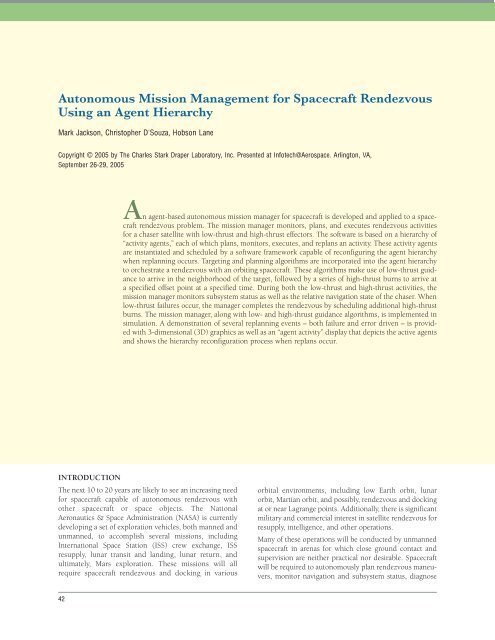TECHNOLOGY DIGEST - Draper Laboratory
TECHNOLOGY DIGEST - Draper Laboratory
TECHNOLOGY DIGEST - Draper Laboratory
Create successful ePaper yourself
Turn your PDF publications into a flip-book with our unique Google optimized e-Paper software.
Autonomous Mission Management for Spacecraft Rendezvous<br />
Using an Agent Hierarchy<br />
Mark Jackson, Christopher D'Souza, Hobson Lane<br />
Copyright © 2005 by The Charles Stark <strong>Draper</strong> <strong>Laboratory</strong>, Inc. Presented at Infotech@Aerospace. Arlington, VA,<br />
September 26-29, 2005<br />
INTRODUCTION<br />
An agent-based autonomous mission manager for spacecraft is developed and applied to a spacecraft<br />
rendezvous problem. The mission manager monitors, plans, and executes rendezvous activities<br />
for a chaser satellite with low-thrust and high-thrust effectors. The software is based on a hierarchy of<br />
“activity agents,” each of which plans, monitors, executes, and replans an activity. These activity agents<br />
are instantiated and scheduled by a software framework capable of reconfiguring the agent hierarchy<br />
when replanning occurs. Targeting and planning algorithms are incorporated into the agent hierarchy<br />
to orchestrate a rendezvous with an orbiting spacecraft. These algorithms make use of low-thrust guidance<br />
to arrive in the neighborhood of the target, followed by a series of high-thrust burns to arrive at<br />
a specified offset point at a specified time. During both the low-thrust and high-thrust activities, the<br />
mission manager monitors subsystem status as well as the relative navigation state of the chaser. When<br />
low-thrust failures occur, the manager completes the rendezvous by scheduling additional high-thrust<br />
burns. The mission manager, along with low- and high-thrust guidance algorithms, is implemented in<br />
simulation. A demonstration of several replanning events – both failure and error driven – is provided<br />
with 3-dimensional (3D) graphics as well as an “agent activity” display that depicts the active agents<br />
and shows the hierarchy reconfiguration process when replans occur.<br />
The next 10 to 20 years are likely to see an increasing need<br />
for spacecraft capable of autonomous rendezvous with<br />
other spacecraft or space objects. The National<br />
Aeronautics & Space Administration (NASA) is currently<br />
developing a set of exploration vehicles, both manned and<br />
unmanned, to accomplish several missions, including<br />
International Space Station (ISS) crew exchange, ISS<br />
resupply, lunar transit and landing, lunar return, and<br />
ultimately, Mars exploration. These missions will all<br />
require spacecraft rendezvous and docking in various<br />
42<br />
orbital environments, including low Earth orbit, lunar<br />
orbit, Martian orbit, and possibly, rendezvous and docking<br />
at or near Lagrange points. Additionally, there is significant<br />
military and commercial interest in satellite rendezvous for<br />
resupply, intelligence, and other operations.<br />
Many of these operations will be conducted by unmanned<br />
spacecraft in arenas for which close ground contact and<br />
supervision are neither practical nor desirable. Spacecraft<br />
will be required to autonomously plan rendezvous maneuvers,<br />
monitor navigation and subsystem status, diagnose

















